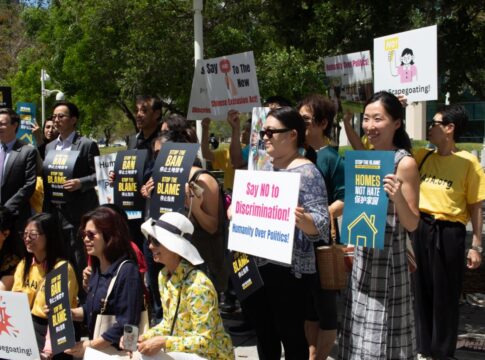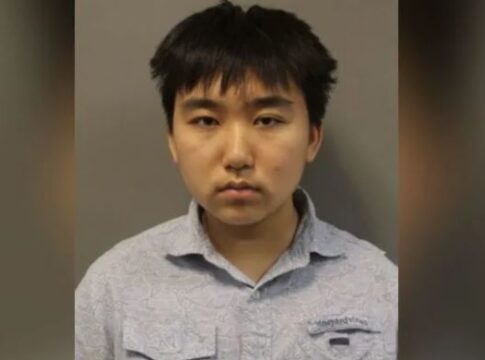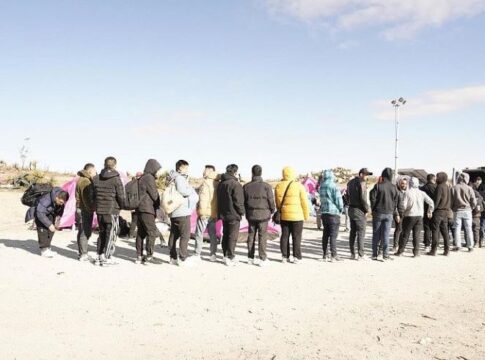
Five Asian Americans — a poet, a graphic artist/novelist, a social justice advocate, a researcher and an artist who defies categorization — are among the 26 “geniuses” named by MacArthur Fellowship. The MacArthur Fellowship is a $625,000, no-strings-attached award to extraordinarily talented and creative individuals as an investment in their potential. Government officials need not apply. The Asian American awardees for 2019 are:
- sujatha baliga, 48: attorney and restorative justice practitioner, Oakland, California. She does not capitalize her name/
- Lynda Barry, 63: graphic novelist, cartoonist and educator, University of Wisconsin-Madison.
- Mel Chin, 67: artist, Egypt Township, North Carolina.
- Jenny Tung, 37: evolutionary anthropologist and geneticist, Duke University.
- Ocean Vuong, 30: poet and fiction writer, University of Massachusetts-Amherst.
The MacArthur Fellows Program is intended to encourage people of outstanding talent to pursue their own creative, intellectual, and professional inclinations. In keeping with this purpose, the Foundation awards fellowships directly to individuals rather than through institutions. There are three criteria for selection of Fellows:
- Exceptional creativity
- Promise for important future advances based on a track record of significant accomplishments
- Potential for the Fellowship to facilitate subsequent creative work.
Although nominees are reviewed for their achievements, the fellowship is not a lifetime achievement award, but rather an investment in a person’s originality, insight, and potential. Indeed, the purpose of the MacArthur Fellows Program is to enable recipients to exercise their own creative instincts for the benefit of human society.
They may use their fellowship to advance their expertise, engage in bold new work, or, if they wish, to change fields or alter the direction of their careers.
LATEST STORIES
The Foundation does not require or expect specific products or reports from MacArthur Fellows and does not evaluate recipients’ creativity during the term of the fellowship. The MacArthur Fellowship is a “no strings attached” award in support of people, not projects. Each fellowship comes with a stipend of $625,000 to the recipient, paid out in equal quarterly installments over five years. Here are the 2019 Fellows:
Ocean Vuong is a poet and fiction writer whose works explore the ongoing trauma of war and conditions of exile with tragic eloquence and clarity. The child of illiterate rice farmers from rural Vietnam, Vuong came to the United States as a refugee with his family at the age of two.
“Language, like people, can be perpetually in flux. Words are, in a sense, bodies moving from one space to another,” he said.
“Our very cells, too, are always moving. They are just overflowing, and dying, and being reborn. What is seemingly so static is actually constantly in motion. Literature, then, is movement—but it is also the measure of movement in our species’ thinking and feeling. To participate in that great migration, as a writer, is the ultimate gift.”
His poetry is infused with the rhythm, cadences, and imagery of rural Vietnamese oral storytelling and folkloric traditions married to a restless experimentation with the English language.
In Night Sky with Exit Wounds (2016), his first full-length collection of poetry, the political and the sensual are often intertwined. Aubade with Burning City is a tableau of the fall of Saigon on April 30, 1975, that juxtaposes the violence on the streets with the ethereal intimacy of lovers’ final moments together. The lyrics of the song White Christmas, which was played on U.S. Armed Forces Radio to signal the final evacuation of American citizens, appear in haunting fragments throughout the poem.
At times, Vuong uses silence to render depth of feeling. Seventh Circle of Earth, about the 2011 murder of a gay couple by immolation in Dallas, Texas, is written in its entirety as footnotes. The footnote numbers run down an otherwise empty page, reinforcing the erasure wrought by the violence, and the text of the poem is formatted as short quotations in the footnotes themselves, with slashes indicating line breaks.
Vuong continues to explore related themes of loss, survival, and the bridging of disparate worlds through language in his novel, On Earth We’re Briefly Gorgeous (2019). Structured as a letter from a son to his mother, who cannot speak English or read in any language, the loosely autobiographical novel is a tangle of personal and colonial histories. In short sections that are each distinct memories, it moves from war-torn Vietnam to a teenager’s first sexual experiences. The language shifts as the narrator makes himself more vulnerable to his interlocutor; the dense prose used to describe childhood memories becomes an elegy, then a meditation, and finally a series of broken phrases about the tragic end of his first love. The novel concludes on a hopeful note, however, with the narrator determined to embrace joy, ambition, and future opportunities for love.
Still early in his career, Vuong is a vital new literary voice demonstrating mastery of multiple poetic registers while addressing the effects of intergenerational trauma, the refugee experience, and the complexities of identity and desire.
Lynda Barry is an educator, cartoonist, and graphic novelist unleashing the creative powers in others through a teaching practice centered on image making and writing. Barry is well known for her decades-long career as a cartoonist and graphic novelist.
Her One! Hundred! Demons! (2002), depicted the life of a Filipina American girl growing up in Seattle with her single mother, her brother and Lola. was the first American comic to use Tagalog in its bubble captions.
Besides Demons, her underground comic strip, Ernie Pook’s Comeek,”her weekly comic strip in alternative newspapers, and graphic novels such as The Good Times Are Killing Me (1988) roadened the psychological dimensions of the format and demonstrated an uncanny capacity to depict the intense emotions of adolescence.
Over the past several years, Barry has turned her focus to education and enabling others to discover their own creativity.
When she was notified of the award, she said, “So that was when I started crying. And then the other thing that happened was after I hung up, both my fists went up into the air, you know, like ‘Woo!,’ like that. But I couldn’t bring them down for a really long time. And the only other time that happened to me was when Obama got elected. I couldn’t bring them down.”
“The honor of it. My god,” the artist said. “It’s just such a magical, amazing thing. I’m so, so excited about the next five years and the work I’m going to be able to do. I’m so grateful for that.”
In her Writing the Unthinkable workshops, she leads students through exercises that emphasize the physical process of writing and drawing, often under time pressure, to stimulate creative thinking: examples of the exercises include drawing a three-minute self-portrait on an index card; keeping a five-minute daily diary of remembered observations from the previous day; filling sixteen frames with specific images, such as faces, while listening to poetry or music.
Barry believes that art provides an alternate lens through which to view ideas and can play an important role in all levels of education. Her Drawbridge program pairs graduate students with four-year-old children in exploration of a topic (such as the difference between the mind and brain), giving graduate students new insight into their research problems as they are forced to use a visual approach, rather than words, to explain them.
In addition to workshops and prolific social media engagement, Barry has shared her teaching approach in a number of publications. What It Is (2008) and Picture This (2010) are playful, interactive workbooks that combine prose with illustrations, incorporating collage, doodles, and handwriting layered onto yellow legal paper. The activity prompts and questions that follow encourage authentic expression and enhanced self-awareness through writing, drawing, thinking, and listening. Her follow-up publication, Syllabus (2014), is a collection of illustrated syllabi that guides the reader through a deliberate practice aimed at discovering novel ways of communicating ideas.
Exuberant and generous as a teacher, Barry is removing the barriers that usually prevent people from writing and drawing and enabling artists and non-artists alike to take creative risks.
Mel Chin is a category-defying artist whose practice calls attention to complex social and environmental issues. In an expansive body of work ranging from collages, sculptural objects, animated films, and video games to large-scale, collaboratively produced public installations, Chin demonstrates a unique ability to engage people from diverse backgrounds and to utilize unexpected materials and places.
Chin initiated the GALA Committee, an artist collective, for the conceptual work In the Name of the Place (1994–1996), in which original works of art appeared in the background of scenes of the television drama Melrose Place. With visual messages that touched on issues like gender, the environment, and global conflict, Chin and collaborators effectively infiltrated the airwaves with challenging and topical art.
Chin was an early pioneer of the practice that now falls under the rubric of socially engaged art, and he has undertaken several community-based projects that address environmental health. For Revival Field (1990–1993), he collaborated with a USDA agronomist to create an experimental “green remediation” garden on the site of a landfill that confirmed a scientific technology. Incorporating aspects of formal garden design, Revival Field is planted with species known to extract heavy metals from toxic soil. Chin’s Fundred Project (2006–present) has involved nearly half-a-million children and adults across the country who create their own paper currency, “fundred dollar bills,” in a collective effort to bring visibility to the widespread threat of lead poisoning. The “Fundred Reserve” has been displayed in museums, schools, and the halls of Congress, where it brought the value of constituent voices directly to members of Congress and served as an educational opportunity for community members and policymakers.
Public spectacle and educational ambitions again combine in Chin’s two-part installation, Wake and Unmoored (2018), which occupied Times Square in 2018. Wake is a large-scale sculpture that assumes the form of a wrecked ship but also resembles the skeletal remains of a beached whale, while Unmoored exists as a mixed-reality experience that enables viewers to glimpse what Times Square would look like submerged under water as sea levels rise due to climate change.
Through these and numerous other projects, Chin is redefining the parameters of contemporary art and challenging assumptions about the forms it can take, the issues it can address, and the settings it can inhabit.
Jenny Tung is an evolutionary anthropologist investigating the interplay between social experiences, genomics, and health. Combining field research with cutting-edge techniques for studying many genes at once, Tung is revealing the molecular mechanisms by which social and environmental stressors have long-lasting impacts on health, longevity, and evolutionary fitness.
Her research with a population of Kenyan baboons living in the wild, about which there is nearly fifty years of longitudinal data, has found that factors such as drought, low social status, and isolation lead to significantly shorter life spans. Importantly, she and collaborators have shown that these experiences can manifest at the genomic and cellular levels, leaving signatures in the way that immune cells function in response to wounds and infections.
Her work with captive rhesus monkeys indicates that such effects are causal: monkeys assigned to lower-ranking status express proinflammatory genes at higher levels than higher-ranking monkeys. These effects can also be reversed—monkeys moved to a higher status demonstrated improved immune systems and corresponding changes in gene expression.
Tung’s research has important implications for human health. While associations between socially induced stress and negative health outcomes have long been observed in humans, her findings suggest there is a causal link between social and environmental adversity and poor health.
Tung is currently expanding her research to non-primate, socially cooperative species such as meerkats, where demarcations of social roles for breeding and nonbreeding “helper” members can clarify the effects of competing demands for growth, reproduction, and immune defense. Tung is illuminating the epigenetic consequences of social behaviors and environmental conditions, thereby advancing the emerging discipline of evolutionary medicine and providing new insights for improving human health.
sujatha baliga
(she doesn’t capitalize her name) is an attorney and restorative
justice practitioner demonstrating the efficacy of survivor-centered
restorative justice alternatives to traditional legal interventions as a
means of helping crime survivors to heal, holding those who have caused
harm accountable, and breaking cycles of recidivism and violence.
In
a statement about the MacArthur award, the Indian American said her
experience as a child sexual abuse survivor was what stoked her interest
in restorative models of justice.
“I didn’t want to be placed in foster care or for my father to be locked up, and I worried that telling the truth might trigger immigration consequences for my family,” she said. “Ultimately, I was drawn to restorative justice because it works best without involving the criminal legal system or other systems of separation and oppression.”
Restorative justice practices encourage constructive, rather than punitive or retributive, responses to wrongdoing. Those who have caused harm, crime survivors, and affected communities come together to participate in a facilitated dialogue and formulate a consensus-based plan for making amends.
As director of the Restorative Justice Project, an initiative of the national innovation and research center Impact Justice, baliga is increasing the availability of restorative justice alternatives for young people in cities across the United States. The project builds upon the success of a pre-charge, restorative justice diversion program baliga launched in Alameda County, California, which, in contrast to other restorative justice programs that focus exclusively on lower-level harms, works with youth who have been arrested for felonies and other serious harms. baliga’s team provides training and technical assistance to similar programs in multiple counties and states that operate in collaboration with community-based organizations and partners from the criminal and juvenile legal systems.
They also collect and evaluate data on rates of recidivism reduction and crime survivor satisfaction from each site to inform the implementation of restorative justice models more broadly and to deepen understanding of their effectiveness among a diverse range of participants and agencies, including community-based organizations, courts, police departments, and district attorneys’ offices.
baliga’s efforts to reduce the juvenile legal system’s reliance on incarceration hold promise for diminishing its highly disproportionate and detrimental effects on communities of color.
In a closely related area of practice, baliga develops and facilitates restorative justice responses to address the complex and specific needs of survivors of intimate partner and sexual violence. She brings to this work not only her skills as an attorney and prior professional experience as both a victim advocate and public defender, but also her own lived experience.
As a survivor of child sexual abuse, she powerfully articulates how punitive systems of criminal justice often fail to offer sufficient familial support and pathways to healing for survivors and frequently have silencing and shaming effects that prolong their suffering. With vision, compassion, and a rigorous, evidence-based approach to implementation, baliga is expanding access to and increasing the visibility of restorative justice practices while honoring their centuries-old, indigenous roots.
AsAmNews has Asian America in its heart. We’re an all-volunteer effort of dedicated staff and interns. Check out our Twitter feed and Facebook page for more content. Please consider interning, joining our staff or submitting a story








